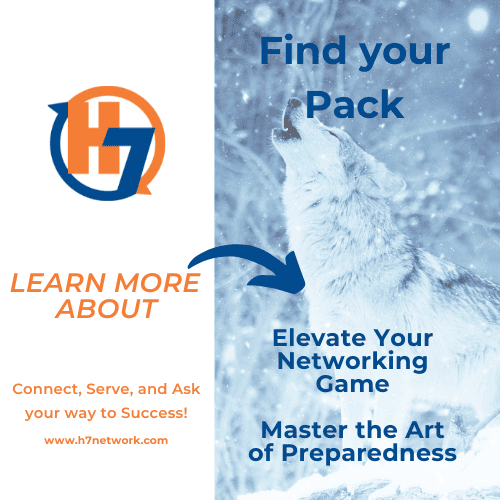
Elevate Your Networking Game Series (1 of 3)
Welcome to the first installment in our series on the Top 3 Best Practices in networking and word-of-mouth marketing by Clay Hicks, CEO and Founder of H7 Network. If you joined us for our first series, “Why Am I Not Getting Referrals?” you are already aware of the hurdles many professionals face in building their business through networking. Today, we delve into Challenge One: Lack of Preparedness with the solution of the Art of Preparedness, and explore how to overcome these challenges forever with the Elevate your Networking Game series.
Networking and word-of-mouth marketing are cornerstones for business growth, yet distinct in nature. Networking often involves attending events and hoping to make meaningful connections with others that may meet with you. In contrast, word-of-mouth marketing is more strategic, hinged on people speaking favorably about you when you’re not present. Both rely heavily on preparation, but they each require a different approach to success. Today, we focus on networking preparation.
Effective networking demands more than just showing up; it requires preparation akin to strategic battle plans (haha). Think of networking as an opportunity to not only expand your contacts but also deepen relationships that could lead to referrals and opportunities. Here are three powerful ways to prepare:
Clarify Your Goals and Target Audience
Reflecting on your networking objectives can make all the difference in ensuring you don’t wander aimlessly at events. Start by identifying your ideal client profile. Understanding who your ideal client is — and being able to communicate this succinctly — is critical. If people seem puzzled when you articulate your needs, it’s likely due to inadequate preparation. Familiarize yourself with the industries you’re interested in reaching, so your conversations are more focused, allowing others to assist you in connecting with the right individuals. Remember, relationships are built on trust — “When you focus on the relationship and not the outcome, your outcomes become more predictable”
Reflection questions:
- How clearly can you define your ideal client in a way that is easier on others? (Attend Activate H7 for better communication)
- What specific outcomes do you hope to achieve by connecting with professionals within your targeted industries, and how will you measure success?
Identify Your Centers of Influence (COIs)
Consider the professionals who operate in complementary fields and whom you can establish mutual referrals with. Think about three (3) professions that serve the same demographic but do not compete with your products or services directly. This clarity will allow you to make your time at networking events highly fruitful. For B2C professionals like Financial Advisors, diversifying potential referral sources beyond the usual CPAs and attorneys might include building relationships with Realtors, Mortgage Brokers, or Property and Casualty Insurance agents instead. These connections often have deep ties to the decision-makers you target.
Reflection questions:
- Which professionals in complementary fields could significantly enhance your network, and how can you establish mutually beneficial relationships with them? Follow this approach as well for support in creating your COIs
- Are you currently focusing on the right referral sources, or could diversifying your connections lead to more opportunities for referrals?
Set Clear Goals and Structure Your Approach
Without specific goals, your networking efforts may lack direction. Implement structures, such as the “10-5-3 rule,” wherein you aim to meet ten new people, connect with five for dedicated one-on-one meetings, and inspire at least three to take action, such as showing interest in your offerings or making an introduction. This approach not only organizes your networking efforts but also allows you to measure success and refine strategies as needed.
Preparation goes beyond setting goals and knowing your audience — it extends to how you ready yourself before entering each event. Utilize resources like LinkedIn to research attendees, engage your professional network for insights, and address any gaps in your preparedness. This proactive mindset will anchor your overall strategy to be more methodical and insightful.
Reflection questions:
- What specific networking goals have you set for your upcoming events, and how do you plan to track progress and effectiveness? Dig into the H7 Resources for Support
- How often do you reevaluate and adjust your networking strategies to ensure alignment with your business objectives and personal growth?
“Elevate Your Networking Game” series:
👉 Blog 1 of 3: Art of Preparedness
👉 Blog 2 of 3: Three Pillars of Effective Communication: Learn more
👉 Blog 3 of 3: Build Relationships with Ease: Learn more
Breaking Habits: Rethink Your Approach
Consider whether ingrained habits might be limiting your networking potential. You may have been networking without a tangible strategy in mind, leading to fatigue and burnout. Challenge the status quo and redefine your approach by incorporating new tactics. You might discover untapped opportunities for building robust, Trusted-Champion Relationships — and ultimately, garnering referrals.
Showing up prepared is indeed half the battle. By embracing these strategies, you can transform your networking experience from a sporadic endeavor into a powerful tool for building trusted, influential relationships. As we continue this series, stay tuned for more insights into conquering the factors that might be hindering your referral growth. Until then, prepare to win and embrace the art of preparedness. Are you ready to elevate your networking game?

Written by: Clay Hicks
“When you focus on the relationship and not the outcome, your outcomes become more predictable”

